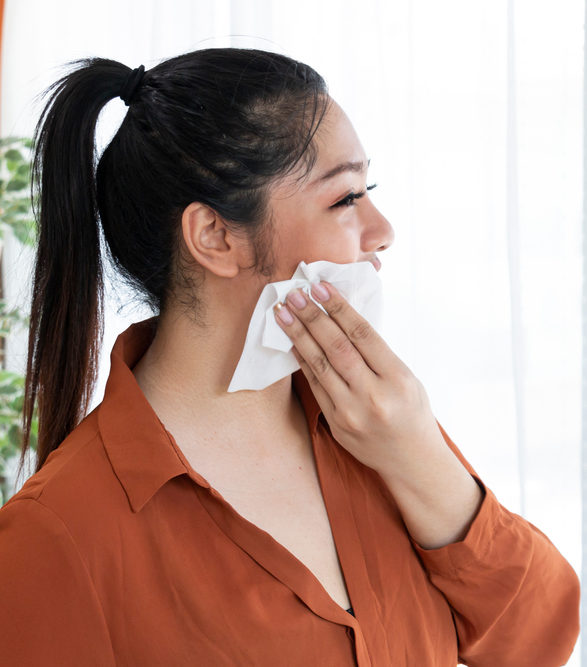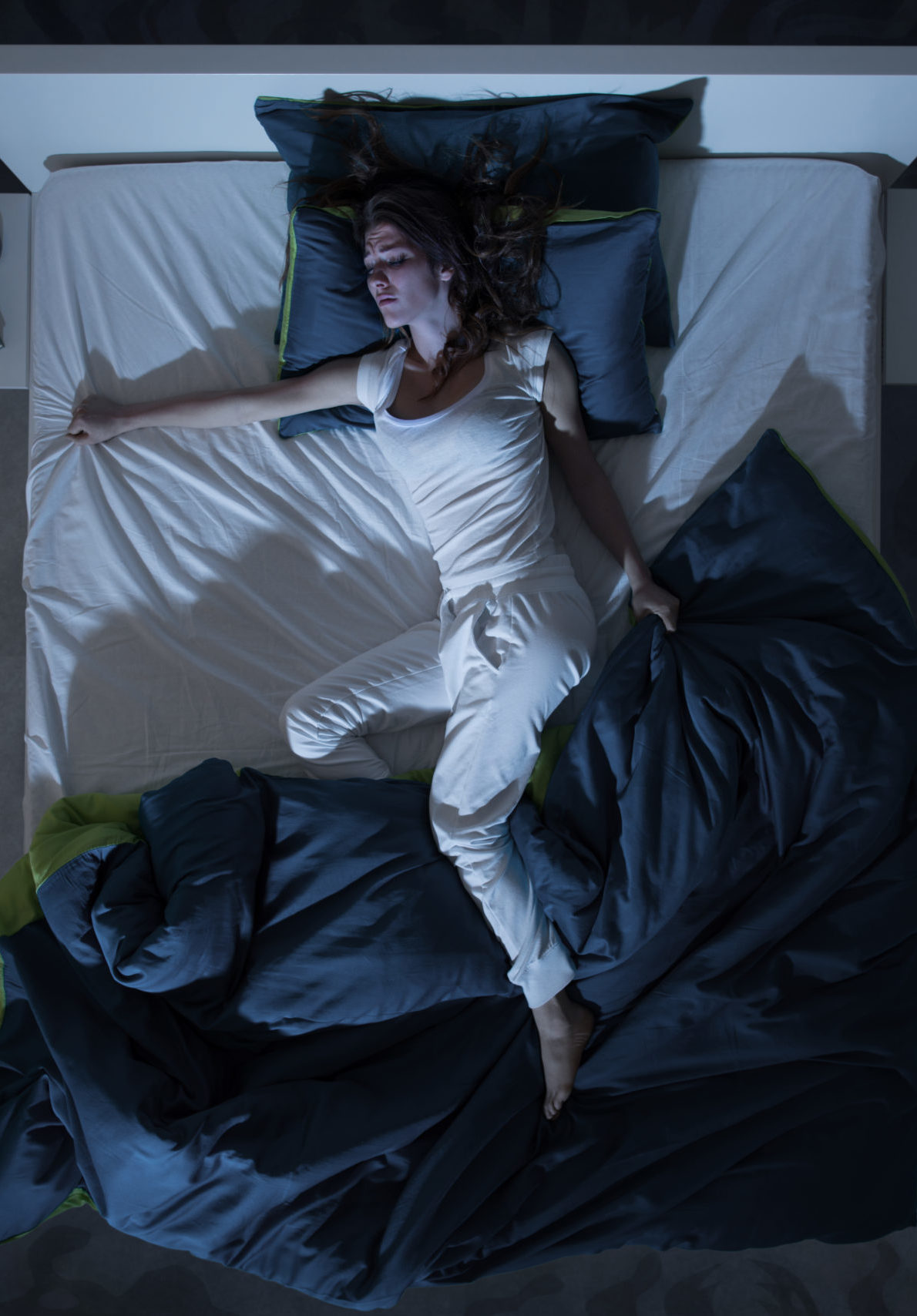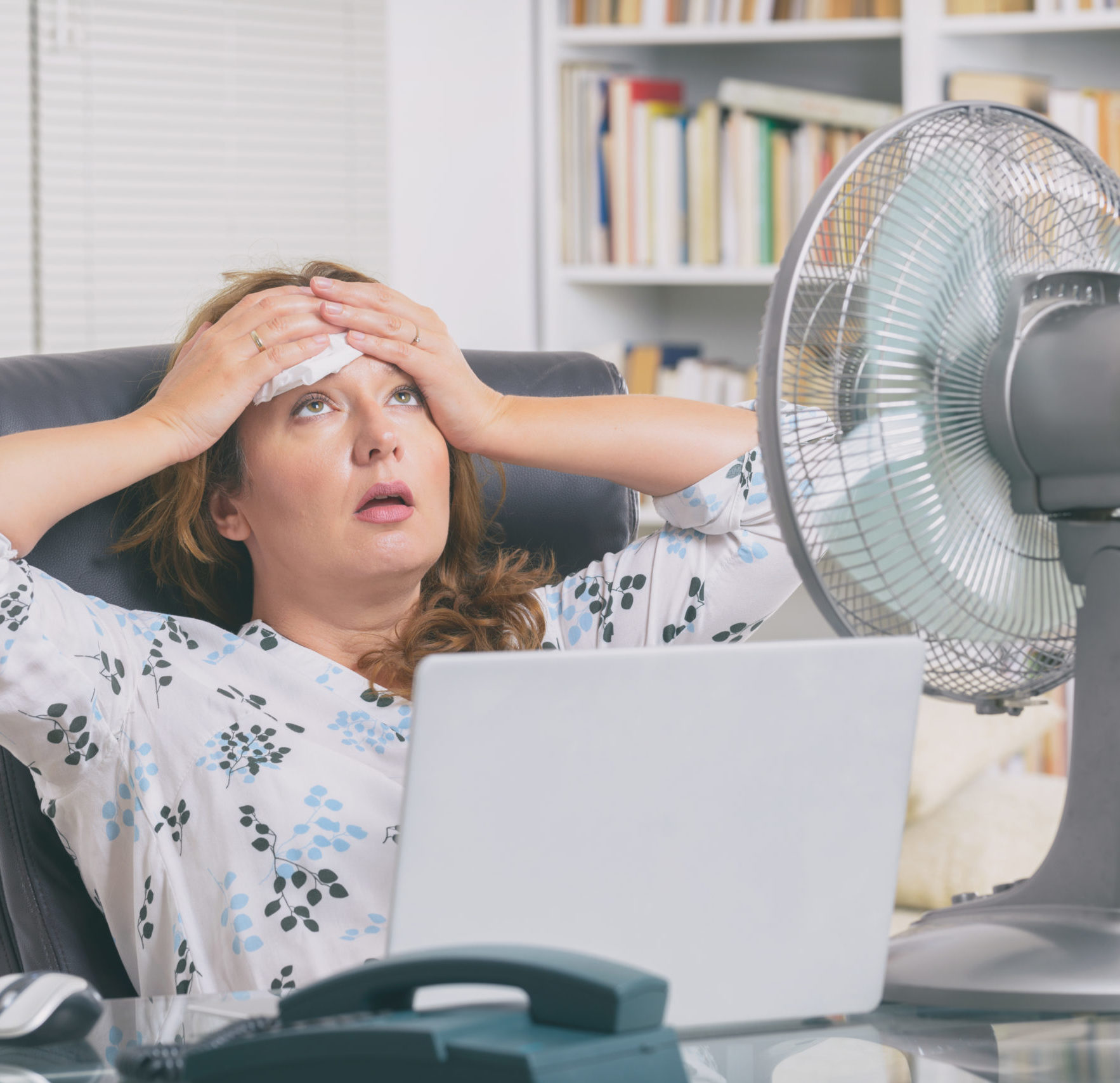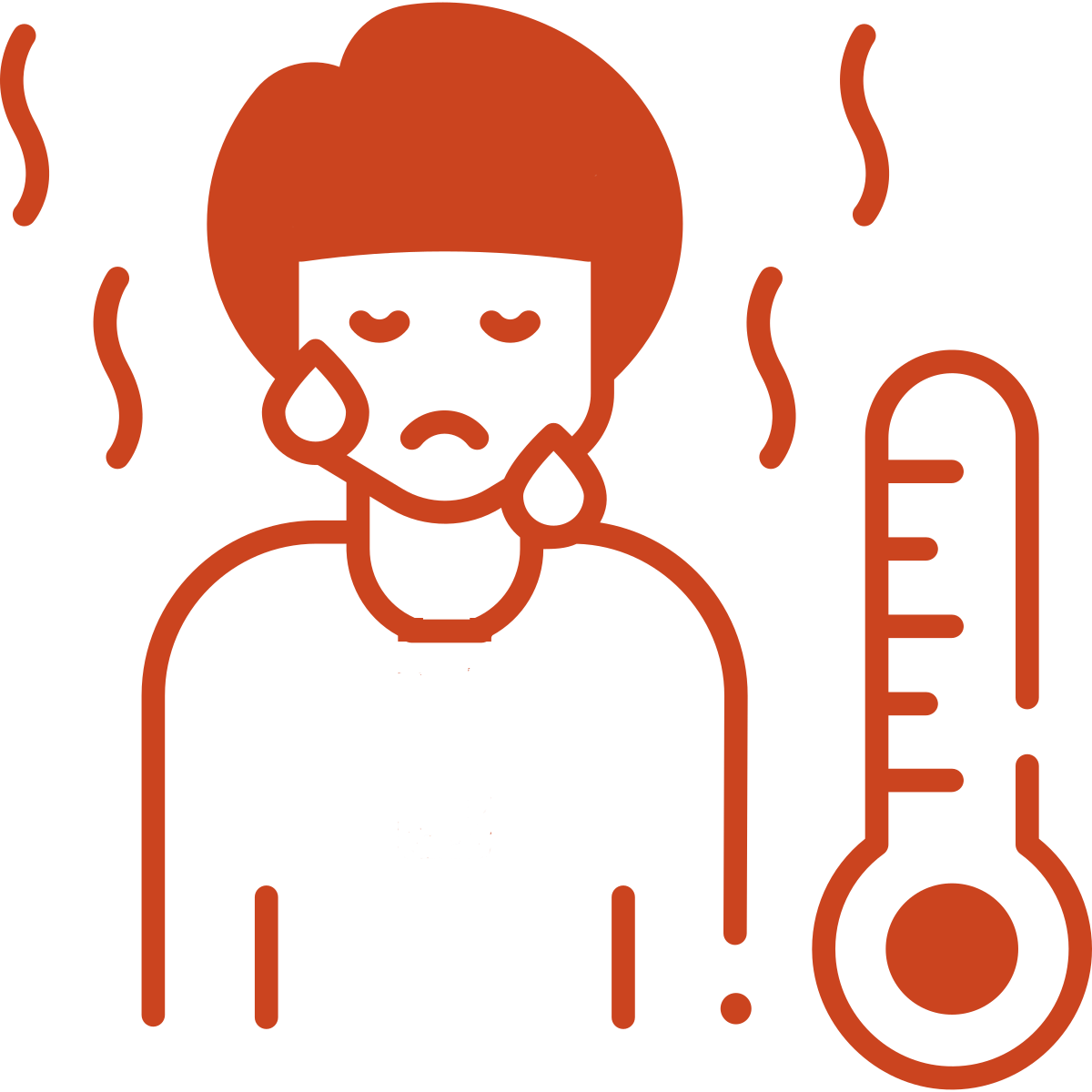What are Hot Flashes and Night Sweats?
Hot flashes and night sweats are a type of vasomotor symptom, which occur when the blood vessels constrict or dilate. In Canada and the UK, they may also be referred to as hot flushes.
Hot flashes and night sweats, sweating in sleep, are the most reported perimenopausal symptoms, experienced by 70-85% of women at some point during the menopausal transition. Hot flashes and night sweats feel like a strong wave of heat traveling through the upper body and face. This is followed by sweating and sometimes chills.

Hot flashes may be felt as:
- A sudden sensation of heat in body and in the face
- Feelings of anxiety, rapid heartbeat or heart palpitations
- Occasional chills at the end of hot flash
- Sensitivity to small increases in room temperature
- Sweating as the body tries to lower body temperature
Flashes can be very short or last up to a few minutes, and occur at any time of day. However, they are reported to occur most frequently between 6-8 AM and 6-10 PM.
Hot flashes begin during perimenopause but may persist post-menopause. Approximately 25% of women continue to experience hot flashes up to 5 years or more after menopause.
Hot flashes and night sweats are often most intense at the start of perimenopause. They can vary from very mild to severe, which can lead to sleep deprivation. They may be accompanied by pain, sudden anxiety or depression.
Current research indicates that Black women may have more intense hot flashes than others, as do heavier women.
Self-care & Natural Remedies for Hot Flashes & Night Sweats
There are a number of techniques you can try to minimize the frequency or alleviate the severity of hot flashes.
- Dress in layers of loose clothing
- Stay hydrated
- Practice good sleep hygiene including sleeping in a cooler room and consider cooling pillows and sheets
- Limit or avoid spicy foods, alcohol, caffeine, and smoking
- Improve circulation with healthy cardiovascular exercise. This has the added benefit of improving sleep quality and increasing metabolism
- Avoid quick temperature changes, such as hot tubs, saunas and warm rooms
- Identify and minimize stressors, which can be triggers for hot flashes
- Use yoga, meditation or relaxation techniques to manage the stress that accompanies hot flashes
- Keep extra sleepwear handy for a late-night change of clothes and flip your pillow over to the cool side to get back to sleep
Hot flashes are linked to insomnia and increased risk of cardiovascular disease, so being proactive about managing them has added benefits into the future. Triggers and successful interventions for hot flashes can vary woman-to-woman, so journaling or tracking hot flashes alongside common stressors may improve your experience.

Therapy & Treatment for Hot Flashes and Night Sweats
If you do not already have a healthcare practitioner who is familiar with identifying and treating symptoms of menopause, the North American Menopause Society provides a list of menopause practitioners here.
Prescriptions for safe and FDA-approved Hormone therapy (HT) with estrogen are available and often effective for reducing hot flashes and night sweats. Oral contraceptives (estrogen and progestin) have shown effectiveness in randomized studies. However, these come with possible side effects such as nausea, migraines and breakthrough uterine bleeding. All options should be carefully discussed with a medical care provider. Many women have success managing their hot flashes with the simple methods listed in the self-care section.
Breast cancer patients may require non-HT therapies to relieve strong hot flashes. Options include blood pressure-lowering medications or low-dose antidepressants.
New hot flash therapies are currently under development. These include a medication named MNGX-100, which blocks the action of a type of inflammatory cytokine (a molecule involved in the inflammatory response called G-CSF) from disturbing your internal thermostat.
As estrogen levels start to lower during the menopausal transition, levels of a neurochemical messenger called Neurokinin-B (NKB) increase. NKB can trigger hot flash responses in the brain’s thermostat. A drug currently in development, SJX-653, blocks NKB action. SJX-653 is being tested as a non-hormonal therapy for moderate to severe vasomotor symptoms. Another treatment, Bijuvia, is an FDA-approved drug made of “Bioidentical Hormones” that are copies of natural estrogen (19-β estradiol) and progesterone. This drug may prove to be helpful for managing hot flashes and night sweats.

NAMS Recommendations for Naturopathic Remedies and Hot Flashes
There is hot flash relief! Many naturopathic therapies advertise their success with natural remedies for hot flashes. In 2015, the North American Menopause Society (NAMS) released a position statement on non-hormonal management of vasomotor symptoms including hot flashes and night sweats. [4]
This position statement is aimed at clinicians, to keep them informed about what the scientific evidence shows with respect to the many non-hormonal (naturopathic) hot flashes treatment options. The goal is to provide evidence-based guidance that can prevent the use of inappropriate or ineffective therapies and to support the use of effective supplements for hot flashes and other treatments.
NAMS Recommended
* Cognitive behavioral therapy (CBT), a common form of talk therapy, and clinical hypnosis have been shown to be effective in reducing vasomotor symptoms (VMS).
* Paroxetine salt is the only non-hormonal medication approved by the US Food and Drug Administration for the management of VMS, although other selective serotonin reuptake/norepinephrine reuptake inhibitors (SSRIs), gabapentinoids, and clonidine show evidence of efficacy.
Learn MoreNAMS Recommended with caution
* Weight loss
* Mindfulness-based stress reduction
* S-equol derivatives of soy isoflavones, and stellate ganglion block (additional studies of these therapies are warranted)

NAMS Does not recommend at this time
There are negative, insufficient, or inconclusive data suggesting the following should not be recommended as proven (ie scientifically supported and guaranteed) therapies for managing VMS, although many may help individual women:
* cooling techniques
* avoidance of triggers such as alcohol and spicy food
* exercise
* yoga
* paced respiration
* relaxation
* over-the-counter supplements and herbal therapies
* acupuncture, calibration of neural oscillations
* chiropractic interventions
The Science
Although medical professionals are still uncertain about night sweats causes, current research points to disturbances in the temperature-regulating (hypothalamus) and heat-sensing (insula and anterior cingulate cortex) areas of the brain.
Rapid drops in estrogen may cause the hypothalamus thermostat to overreact to small increases in heat, due to neurochemical messages. As a result of this overreaction, the hypothalamus triggers a series of actions in an attempt to rapidly cool the body. Increased blood flow is directed to the face, neck and torso where dilated blood vessels close to the skin’s surface can help cool the blood supply. This occurs alongside increased sweating to further cool the skin and the underlying blood vessels.
During hot flashes, MRI brain studies of perimenopausal women show that temperature sensors are activated in the brain and signal a sense of strong heat.
Other evidence points to inflammatory cytokine chemical messengers, released from immune system cells, interfering with the thermostat and sensory parts of brains in perimenopausal women.
Statistics
Hot flashes and night sweats can have a profound impact on quality of life during menopause.
Hot flashes can be very disruptive to your daily life. They feel like a strong wave of heat travelling through your body followed by sweating and sometimes chills when the hot flash is over. You may also have feelings of anxiety, a rapid heartbeat, or your heart skips a beat or two.
It is impossible to predict exactly how long you will experience hot flashes, but menopause symptoms can last for many years.
Menopausal hormone therapy (MHT) is the gold standard treatment for hot flashes, and you and your doctor can determine which type of hormone therapy is the best for your body and your symptoms. Self-care includes dressing in layers, staying hydrated and avoiding spicy foods and hot drinks that can be triggers.
FALSE
Heavy smokers and drinkers, and women with nutrient deficiencies may experience hot flashes.
MYSTERY
As scientists unravel the science of hot flashes, they are also using this information to develop new treatments.
MYSTERY
Medical research isn’t clear on how hot flashes are triggered, but unstable and decreasing estrogen levels, plus the chemical messages of inflammation, may upset the body’s “thermostat” in the brain.
FALSE
However, they can trigger persistent insomnia which should be treated since chronic insomnia is dangerous.
Compiled References
- Brinton, R. D., Yao, J., Yin, F., Mack, W. J., & Cadenas, E. (2015). Perimenopause as a neurological transition state. Nature reviews. Endocrinology, 11(7), 393–405. https://doi.org/10.1038/nrendo.2015.82
- Bulan, S. E. (2019). Physiology and Pathology of the Female Reproductive Axis. In Melmed, S., Koenig, R., Rosen, C., Auchus, R. & F. Goldfine (Eds.), Williams Textbook of Endocrinology (14th ed., pp. 574-641). Elsevier.
- Minkin M. J. (2019). Menopause: Hormones, Lifestyle, and Optimizing Aging. Obstetrics and Gynecology Clinics of North America, 46(3), 501–514. https://doi.org/10.1016/j.ogc.2019.04.00
- El Khoudary, S. R., Aggarwal, B., Beckie, T. M., et al. (2020). Menopause Transition and Cardiovascular Disease Risk: Implications for Timing of Early Prevention: A Scientific Statement From the American Heart Association. Circulation, 142(25), e506–e532. https://doi.org/10.1161/CIR.0000000000000912
- The NAMS 2017 Hormone Therapy Position Statement Advisory Panel (2017). The 2017 hormone therapy position statement of The North American Menopause Society. Menopause (New York, N.Y.), 24(7), 728–753. https://doi.org/10.1097/GME.0000000000000921
- Fred Hutchinson Cancer Research Center Survivorship Program. Survivorship Clinic: Menopausal Symptoms. https://www.fredhutch.org/content/dam/www/research/patient-treatment-and-support/survivorship-program/survivorship-health-links/Menopausal%20Symptoms.pdf
- The North American Menopause Society (n.d.). Menopause Symptoms and Treatments. http://www.menopause.org/for-women/menopauseflashes/menopause-symptoms-and-treatments
- MenoGeniX (n.d.). Menopause. https://www.menogenix.com/menopause
- Sojournix Inc. (n.d.). Company Overview. https://www.sojournixpharma.com/sojournix-overview
- Guthrie, J. R., Dennerstein, L., Hopper, J.L. & H.G. Burger. (1996). Hot flushes, menstrual status, and hormone levels in a population-based sample of midlife women. Obstetrics & Gynecology, 88(3), 437-442. https://doi.org/10.1016/0029-7844(96)00196-2
- Santoro, N., Epperson, C. N., & Mathews, S. B. (2015). Menopausal Symptoms and Their Management. Endocrinology and Metabolism Clinics of North America, 44(3), 497–515. https://doi.org/10.1016/j.ecl.2015.05.001
Original content, last updated February 22, 2023.
© 2025 Herstasis® Health Foundation





